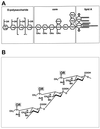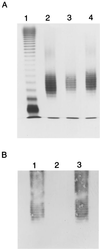Molecular cloning and characterization of a locus responsible for O acetylation of the O polysaccharide of Legionella pneumophila serogroup 1 lipopolysaccharide
- PMID: 10383989
- PMCID: PMC93911
- DOI: 10.1128/JB.181.13.4137-4141.1999
Molecular cloning and characterization of a locus responsible for O acetylation of the O polysaccharide of Legionella pneumophila serogroup 1 lipopolysaccharide
Abstract
Complementation experiments, Tn5 mutagenesis, and DNA sequencing were used to identify a locus (lag-1) that participates in acetylation of Legionella pneumophila serogroup 1 lipopolysaccharide. Nuclear magnetic resonance analyses of lipopolysaccharides from mutant and complemented strains suggest that lag-1 is responsible for O acetylation of serogroup 1 O polysaccharide.
Figures




Similar articles
-
Distribution of lag-1 Alleles, ORF7, and ORF8 Genes of Lipopolysaccharide and Sequence-Based Types Among Legionella pneumophila Serogroup 1 Isolates in Japan and China.Front Cell Infect Microbiol. 2019 Aug 5;9:274. doi: 10.3389/fcimb.2019.00274. eCollection 2019. Front Cell Infect Microbiol. 2019. PMID: 31448241 Free PMC article.
-
Complex O-acetylation in Legionella pneumophila serogroup 1 lipopolysaccharide. Evidence for two genes involved in 8-O-acetylation of legionaminic acid.Biochemistry. 2001 Jun 26;40(25):7630-40. doi: 10.1021/bi002946r. Biochemistry. 2001. PMID: 11412117
-
A point mutation in the active site of Legionella pneumophila O-acetyltransferase results in modified lipopolysaccharide but does not influence virulence.Int J Med Microbiol. 2001 Nov;291(5):345-52. doi: 10.1078/1438-4221-00140. Int J Med Microbiol. 2001. PMID: 11727818
-
The lipopolysaccharide of Legionella pneumophila serogroup 1 (strain Philadelphia 1): chemical structure and biological significance.Prog Clin Biol Res. 1995;392:113-39. Prog Clin Biol Res. 1995. PMID: 8524918 Review.
-
Genetics of Legionella pneumophila virulence.Annu Rev Genet. 1992;26:51-69. doi: 10.1146/annurev.ge.26.120192.000411. Annu Rev Genet. 1992. PMID: 1482124 Review. No abstract available.
Cited by
-
A hospital-associated outbreak of Legionnaires' disease caused by Legionella pneumophila serogroup 1 is characterized by stable genetic fingerprinting but variable monoclonal antibody patterns.J Clin Microbiol. 2003 Jun;41(6):2503-8. doi: 10.1128/JCM.41.6.2503-2508.2003. J Clin Microbiol. 2003. PMID: 12791873 Free PMC article.
-
Genomic heterogeneity differentiates clinical and environmental subgroups of Legionella pneumophila sequence type 1.PLoS One. 2018 Oct 18;13(10):e0206110. doi: 10.1371/journal.pone.0206110. eCollection 2018. PLoS One. 2018. PMID: 30335848 Free PMC article.
-
Distribution of lag-1 Alleles, ORF7, and ORF8 Genes of Lipopolysaccharide and Sequence-Based Types Among Legionella pneumophila Serogroup 1 Isolates in Japan and China.Front Cell Infect Microbiol. 2019 Aug 5;9:274. doi: 10.3389/fcimb.2019.00274. eCollection 2019. Front Cell Infect Microbiol. 2019. PMID: 31448241 Free PMC article.
-
A structural comparison of lipopolysaccharide biosynthesis loci of Legionella pneumophila serogroup 1 strains.BMC Microbiol. 2013 Sep 4;13:198. doi: 10.1186/1471-2180-13-198. BMC Microbiol. 2013. PMID: 24069939 Free PMC article.
-
Current and emerging Legionella diagnostics for laboratory and outbreak investigations.Clin Microbiol Rev. 2015 Jan;28(1):95-133. doi: 10.1128/CMR.00029-14. Clin Microbiol Rev. 2015. PMID: 25567224 Free PMC article. Review.
References
-
- de Bruijn F J, Lupinski J R. The use of transposon Tn5 mutagenesis in the rapid generation of correlated physical and genetic maps of DNA segments cloned into multicopy plasmids. Gene. 1984;27:131–149. - PubMed
-
- Dournon E, Bibb W F, Rjagopalan P, Desplaces N, McKinney R M. Monoclonal antibody reactivity as a virulence marker for Legionella pneumophila serogroup 1 strains. J Infect Dis. 1988;157:496–501. - PubMed
MeSH terms
Substances
Associated data
- Actions
LinkOut - more resources
Full Text Sources
Other Literature Sources
Molecular Biology Databases

